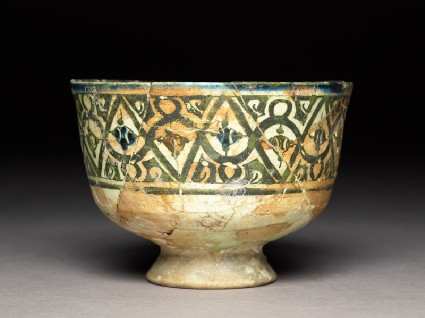Browse: 285 objects
- Reference URL
Actions
Stem bowl with geometric frieze and pseudo-kufic inscription
-
Details
- Associated place
- Date
- 13th century (1201 - 1300)
- Material and technique
- fritware, with underglaze painting in black, red, and blue
- Dimensions
-
9.2 cm (height)
12.6 cm (diameter)
at foot 6 cm (diameter)
- Material index
- Technique index
- Object type index
-
container › vessel › bowl › stemmed bowl
- No. of items
- 1
- Credit line
- Gift of Gerald Reitlinger, 1978.
- Accession no.
- EA1978.2214
-
Further reading
Oxford: Ashmolean Museum, 18 July-13 September 1981, and London: Sotheby Parke Bernet, 1981, Eastern Ceramics and Other Works of Art from the Collection of Gerald Reitlinger: Catalogue of the Memorial Exhibition, Deborah Willis, ed. (Oxford: Ashmolean Museum and London: Sotheby Parke Bernet, 1981), no. 371 on p. 128, illus. p. 128
Glossary (3)
fritware, kufic, underglaze painting
-
fritware
Ceramic material composed of ground quartz and small quantities of clay and finely ground frit (frit is obtained by pouring molten glass into water).
-
kufic
A term denoting various styles of angular Arabic script. Emerged in the early centuries of Islam, kufic soon became the preferred hand to copy holy texts.
-
underglaze painting
Painting applied to ceramic material before a transparent, or monochrome or coloured glaze for Islamic objects, is applied. The technique was initially developed in China.
Location
-
- currently in research collection
Objects are sometimes moved to a different location. Our object location data is usually updated on a monthly basis. Contact the Jameel Study Centre if you are planning to visit the museum to see a particular object on display, or would like to arrange an appointment to see an object in our reserve collections.
© 2013 University of Oxford - Ashmolean Museum

